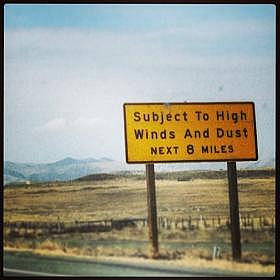Just One Breath: Valley fever picture complicated by changing climate

With the right 'grow and blow' conditions, valley fever might thrive after a drought, experts say. Credit Rebecca Plevin / Valley Public Radio
We know what causes valley fever. The coccidioides fungus that thrives throughout the Central Valley in California and other parts of the Southwest sends out spores. When conditions are dry and dusty, the wind carries these spores. People breathe them in, and the fungus causes an infection in people’s lungs that can spread throughout the body.
So it would follow that if conditions are drier for longer periods that we would see more valley fever. That’s why valley fever researchers are concerned that the recent drought in California will lead to a rise in valley fever cases and, potentially, deaths.
Kellie Schmitt, then at the Bakersfield Californian, and Rebecca Plevin, then at Vida en el Valle, reported on the possible links between climate and valley fever in 2012. And Plevin returned to this question last week for a story for Valley Public Radio. Microbiologist and valley fever expert Antje Lauer told Plevin:
With an ongoing drought, you can hypothesize that you will have more and more areas where the valley fever fungus might occur, simply because its antagonists in the soil aren’t there anymore.
Why is Lauer hypothesizing and not simply stating that more dry soil means more valley fever? Because, as with much of the science around the disease, the evidence base is still being built. Here are three reasons for that. Studies are scarce. Data collection was erratic for years and continues to be spotty. And the ability to link something as widespread as rain over an entire region with health effects in individuals is a big, complicated task.
In 2001, in the journal Aerobiologia, Korine Kolivras at the Department of Geography and Regional Development at The University of Arizona, and colleagues wrote:
Most prior work on valley fever was conducted decades ago, and focused mainly on the distribution of C. immitis, different phases of its lifecycle, and other aspects of valley fever. Only passing references are made in most studies to the role of climate in the fungus’ lifecycle and subsequent outbreaks of valley fever. A few studies outlined the climatic characteristics of the study area or attempted to create conditions similar to the external environment in a laboratory, but little has been done quantitatively that shows a specific relationship between climatic conditions and incidence of valley fever.
Some of the first studies talking about climate and valley fever date back to the 1950s and 1960s, but, for the most part, the scientific literature is pretty thin on this point until the late 1990s. Benjamin Park, the leading fungal disease expert at the CDC, and colleagues took the science forward in 2005, writing in the Journal of Infectious Diseases:
Climatic variables describing hot, dry conditions had the strongest association with incidence. A Poisson regression model successfully recreated the observed seasonality during 1998–2001, including the large peak beginning in November 2001.
And it’s not just about the heat. It’s about the amount of rain before and after the heat. Studies have continued to show a link between the amount of rain that areas with valley fever receive and a spike in valley fever cases in the following years. The same year as Park’s study, Andrew Comrie wrote in Environmental Health Perspectives that the specific amount of rain in the fall and winter before a dry summer can have a strong effect on how much valley fever is seen in the following year. And he also wrote:
However, the most striking result of this study is the dominant role of precipitation during the normally arid foresummer 1.5–2 years before the season of exposure. Even when considered alone, April–June precipitation accounts for more than one-quarter of the overall variance in subsequent seasonal coccidioidomycosis incidence.
Why and how this happens continue to be the subject of research by Lauer and others. One thing they are examining is the difference in geographies. What researchers found in Arizona is that a pattern of rain-drought-wind led to more valley fever there.
“So you have a rain event that puts it in the soil and gets the fungus growing, then a period of drying out, and then you have this blowing and aerosolizing of spores,” Heidi Brown at the University of Arizona told Plevin. “That’s the system that we seem to see – pretty strong relationship that we’re seeing here in Arizona.”
But Plevin also wrote:
That association doesn’t quite translate to California, and experts don’t know why. But they suspect it might have something to do with differences in soil, environment or even the susceptibility of people in the two regions. “We’ve tried to come up with some models here in Kern County to see if some of environmental factors were predictive of increases in epidemics,” says Kirt Emery, a Kern County epidemiologist. “We have not been successful.”
Here’s the exciting news. All of the research activity now seems poised to yield a powerful prediction tool for preventing future valley fever outbreaks. As Comrie wrote:
Important public health opportunities exist if environmental factors controlling coccidioidomycosis outbreaks and trends can be better comprehended, including the timing and degree of mitigation efforts such as soil treatment and the development of an advance warning system for public health management.

